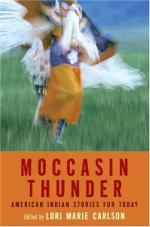|
This section contains 3,584 words (approx. 12 pages at 300 words per page) |

|
SOURCE: “American Indian Persistence and Resurgence,” in Boundary 2, Vol. 19, No. 3, Fall, 1992, pp. 1-25.
In the following excerpt, Kroeber examines the idea of “writing Indians” in the fiction of James Fenimore Cooper and John Rollin Ridge.
Writing Indians
What I have called the ethnological phase of Indian post-Columbus experience began to emerge in the first quarter of the nineteenth century, when Washington Irving wrote sympathetically of King Phillip in his war with the New England colonists in the seventeenth century; when Henry Schoolcraft, after composing an epic poem on the Creek wars, began something like scientific research into Indian lifeways; when artists such as Bodmer, Caitlin, and Charles Bird King painted Indians and scenes of Indian life; and, above all, when James Fenimore Cooper's Leatherstocking novels were enthusiastically received throughout Europe, as well as in America. Cooper's work spawned literally thousands of stories—right down to the film Dances...
|
This section contains 3,584 words (approx. 12 pages at 300 words per page) |

|


